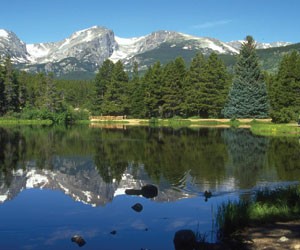While the term green meeting most often refers to a meeting's carbon footprint, groups can experience green in the truest sense of the word by taking advantage of parks and conservation areas all across the West.
Some offer lodging and meeting space, while others make for an ideal day trip filled with activities tailored for groups. Here is a small sampling of group-friendly parks and preserves to consider.
Glacier National Park
www.nps.gov/glac
Glacier National Park, dubbed the "Crown of the Continent," spans thousands of miles of snow-capped Rocky Mountain peaks throughout northwest Montana, encompassing mountains and glacial waters, among other features. A number of companies based in the park offer group activities.
"Groups can utilize all of our concession activities," says Ellen Blickhan, acting public affairs specialist for Glacier National Park. "Some lend better to a larger group size—for instance, boat tours on all our lakes. In some cases groups might even be able to fill a boat."
Glacier Park Boat Company (http://glacierparkboats.com) offers tours in four different locations and also rents kayaks, motorboats and rowboats and canoes. Another option is renting a boat from Lake MacDonald Lodge.
Horseback riding is also available for groups, with Swan Mountain Outfitters (www.swanmountainoutfitters.com/glacier), offering trail rides from Lake MacDonald, Many Glacier and Apgar.
"Back in the early days, the park was home to about 1,000 head of horses," Blickhan says. "Now our concession operates on a much smaller basis."
For auto touring, Sun Tours (http://glaciersuntours.com) offers group options with its Native American Cultural Tours, as do the park's Red Buses, a historic fleet dating to the 1930s. These 17-passenger convertible touring sedans run a variety of routes throughout the park, including Logan Pass, which climbs to 6,646 feet—the highest point on the Going-to-the-Sun Road.
Glacier Wilderness Guides (www.glacierguides.com) focuses on group hiking trips, ranging from day hikes to overnight excursions to the back country. The National Park Service also offers ranger-led interpretive walks from the middle of June through Labor Day.
Winter activities in the park include cross-country skiing options and weekend snowshoeing tours from January to the end of March.
Groups can attain permits to use some of the facilities in the park, among them the Fish Creek Amphitheater and Apgar Amphitheater. There are also picnic areas in the park that can be used for receptions.
There are a handful of historical properties inside the park with limited space, such as Many Glacier Hotel, while in nearby Whitefish, the year-round Grouse Mountain Lodge offers meeting space.
Rocky Mountain National Park
www.nps.gov/romo
In Colorado, Rocky Mountain National Park, located northwest of Boulder, spans over 265,770 acres and features the headwaters of the Colorado River. The park straddles the Continental Divide, giving it two distinct characters, the west side more heavily forested and the east side offering glaciated peaks. The park headquarters, Beaver Meadows Visitor Center, is an attraction itself, designed by the Frank Lloyd Wright School of Architecture at Taliesin West and deemed a National Historic Landmark.
Groups staying in Estes Park, the gateway to Rocky Mountain National Park, are within minutes of all the park's allures, and can arrange tours of the park through the Estes Park CVB.
"Once the group is here, they have a great setting," says Karen Lynch, director of group sales and marketing for the Estes Park CVB. "The park has some of the best snowshoeing in world, cross-country skiing, sledding. There are also photography tours, where groups can spend the whole day, from sunrise to sunset."
Rocky Mountain Rush (www.rockymountainrush.com) provides custom jeep tours of the park, while Kirk's Mountain Adventures (www.kirksflyshop.com) offers everything from fly-fishing trips in the park to llama pack adventures, all open to groups.
"Most groups staying here go to Rocky Mountain National Park, but they can also go to Estes Park," Lynch says. "The town is like Whoville—neat little shops, a river walk, a winery for wine tasting, and the downtown section is also a draw."
Estes Park is known for its abundance of wildlife, namely elk, moose, eagles and other bird species. On Lake Estes, groups can rent pontoon or paddleboats at the marina or bike around the lake.
"You're looking at the mountains and don't see anything but beauty," Lynch says.
There are a number of options for hotels in Estes Park, including the Stanley Hotel, where Stephen King wrote and filmed The Shining.
Wells Gray Provincial Park
www.wellsgray.ca
Though Wells Gray Provincial Park is lesser known than Alberta's Banff or Jasper national parks, this British Columbia institution contains within its boundaries five major lakes, headwaters of both the Clearwater and Murtle rivers and a wealth of wildlife that includes black and grizzly bears, moose, caribou, wolves and cougars. The park is also known for its rainbow trout and salmon fishing. There are glaciers and extinct volcanoes within its borders, as well as over 20 major waterfalls in the more accessible southern part of the park and immediately around its borders, including Helmcken Falls, three times as high as Niagara Falls.
"There are tons of hiking trails in the park," says Merlin Blackwell, park operator. "A lot of these are built on old access roads from when there was mining exploration in the park and on old trapper trails."
Activities in summer include canoe trips on Clearwater, Azure or Murtle lakes and rafting the Clearwater and North Thompson rivers, both of which can be used as team-building outings.
Discover Wells Gray (www.discoverwellsgray.com) offers guided hikes in the park, while Wells Gray Adventures (www.skihike.com) can arrange canoe trips and in winter backcountry cross-country ski trips. The company also organizes hut-to-hut hiking within the park for overnight adventures.
"There are no distractions, no cell phones, no electricity, nowhere to connect with laptops," Blackwell says.
Facilities groups can use in the park include Wells Gray Information Centre, in Clearwater at the entrance of the park. There is an on-site naturalist available for talks and guided hikes, as well as two local descendants of the original settlers in the park who can accompany groups to the old homesteads that still exist within the park and talk about how life was 80 years ago.
At the top of Green Mountain, there is also a viewing platform offering 360-degree park vistas.
"Groups couldn't get a better backdrop," Blackwell says.
Groups will find a number of lodges in the park's vicinity, such as the Wells Gray Guest Ranch, which can be used as a base for day hikes to the Trophy Mountains. Helmcken Falls Lodge is another option for small groups.
California Wolf Center
www.wolfcenter.org
Located 60 miles east of San Diego, the California Wolf Center, founded in 1977, serves as an education, conservation and research center. The center is currently home to 22 wolves in total, including several packs of gray wolves, some of which are exhibited for educational purposes, as well as a small population of highly endangered Mexican gray wolves, now being reintroduced into the southwestern U.S.
With only 50 Mexican gray wolves currently in the wild, the California Wolf Center is an active participant in the Mexican Wolf Species Survival Plan Breeding program, designed to maintain a backup population, and the third-largest facility out of 49 housing the species in captivity.
Staff educators and volunteers are on call to offer information about the state of wolf conservation, as well as information on wolf behavior and the role they play in the environment, according to Erin Hunt, general manager of the California Wolf Center: "We are a 501c3 non-profit. The breeding work we do here and hosting of Mexican wolves is conservation."
Aside from viewing presentations, groups can organize a weekday tour in advance or join one of the scheduled weekend tours. Groups can view two wolf packs every day except Sundays, when the Mexican wolf pack is not accessible.
The center can host up to 100 for tours and can arrange for the education center to be used for a small meeting and the facility for a reception.
Muleshoe Ranch Preserve
www.nature.org
For small groups, Muleshoe Ranch, in the Galiuro Mountains of southern Arizona, offers five casitas that can hold up to 10 people. The ranch, located on semi-desert grasslands straddling the Sonoran and Chihuahuan deserts, is The Nature Conservancy's only CMA, or Cooperative Management Area, with the land at its disposal owned by several different private and government agencies.
"We are the gatekeepers to 50,000 acres of mixed ownership and mixed habitat," says Dae Unick-Todd, manager of guest services of the Muleshoe Ranch Preserve CMA. "Our preserve runs from desert and riparian in the lowlands to maple and pine forest up in the Galiuro Mountains at 8,000 feet."
The CMA has 22 miles of hiking and equestrian trails, with 12 miles of the trail system accessible from the Muleshoe Ranch Visitors Center.
Muleshoe Ranch Preserve maintains five rustic rental guest casitas for those who venture out to explore the preserve.
"We maintain the casitas so that people can get out into one of our preserves to see what the Conservancy is really all about—preserving special habitat," Unick-Todd says.
The casitas are original and renovated historic buildings dating from the late 1800s.
"We would be great for small groups who really want to be unplugged and out of touch for their meeting/retreat," Unick-Todd says. "We don't offer any organized activities. We do provide maps for self-guided hiking in spectacular terrain, because we are an oasis—the birding is very good, and there is nothing like a sweet soak in our hot-spring-fed tubs under our star-filled desert sky. Primarily, we try to promote our remote, quiet, unplugged atmosphere. Out here people have no choice but to slow down and listen to their own thoughts."







